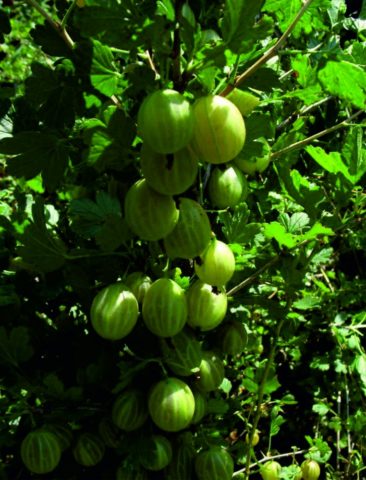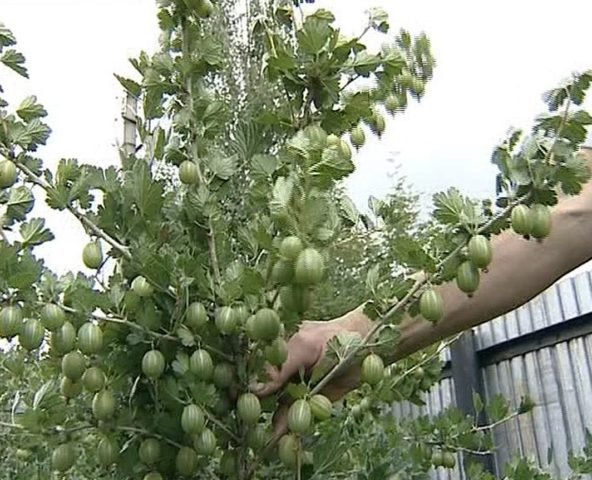Content
Gooseberry “Emerald” is an early variety intended for cultivation in the short Siberian summer. Able to withstand low temperatures. A characteristic feature of the variety, along with frost resistance, is the ability of high fruiting, ease of care and high taste of the fruit. “Emerald” feels comfortable in the conditions of Siberia and the climate of southern latitudes.
History of variety selection
Thornless gooseberry “Emerald” (“Ural emerald”) is the result of breeding work at the South Ural Research Institute in Chelyabinsk. The originator of the variety is considered to be V. S. Ilyin. Gooseberries were obtained from “Perbornets Minusinsk” and “Nugget”. The “Ural Emerald” was created for cultivation in the West Siberian region. In 2000, the variety was included in the State Register.
Description of the gooseberry variety Ural emerald
Characteristic features of a self-fertile early variety of universal use:
- The average height of the Ural Emerald gooseberry is up to 1.5 m, the bush is compact, not wide, but dense, and takes up little space on the site. Shoots are erect, woody, perennial, light brown in color, annuals are green, thin. The thorniness of “Emerald” is low. The shoots are soft and non-thorny. Gooseberries are thornless species.
- The leaf is dark green in color, the structure is uneven, five-lobed with wavy edges. Its sizes are uneven: small, medium, large. The crown is dense.
- The flowers are inconspicuous pinkish in color, medium size, solitary, bisexual. An ovary is formed on each of them.
Description of the gooseberry fruit “Ural emerald”:
- on the bush the fruits are not the same, the weight varies from 3.5 g to 7.5 g;
- round shape;
- the peel is transparent, does not hide a large number of seeds;
- the pulp has a thick consistency of yellow-green color, the seeds are small black;
- the taste of the Ural Emerald variety is sweet with slight sourness;
- The berry is juicy and aromatic.
“Emerald” was created for cultivation in Siberia and the Urals. It was adapted for harsh winters. Gradually, gooseberries spread to the Central Black Earth part of the Russian Federation. Thornless gooseberry “Ural emerald” can be found in areas of the Stavropol and Krasnodar territories.
Characteristics of the variety
The gooseberry variety “Emerald” corresponds to the description stated by the originators in terms of yield and frost resistance. An unpretentious plant that is resistant to diseases and pests has rightfully taken its place as a favorite.
Drought resistance, frost resistance
Gooseberry “Emerald” was created by crossing frost-resistant varieties, so it is not afraid of temperature drops of -35 °C. In severe frosts, a crop without shelter may die. The “Emerald” variety is not drought-resistant; constant watering is required throughout the growing season.
Productivity and fruiting
Hybrid gooseberry “Ural Emerald”, according to gardeners, is a high-yielding variety. 40% self-fertile - the amount of harvest will increase if other varieties are planted nearby, for example, “Beryl" He will act as a pollinator. “Emerald” produces berries with high gastronomic and biological characteristics. Ripens evenly by the end of June to mid-July. The yield from one bush is 4–5.5 kg, depending on the height of the berry crop.
Gooseberries “Ural Emerald” ripen early, so it is recommended to remove ripe berries immediately to prevent shedding. The fruits do not remain on the parent bush after reaching maturity. In hot summers without watering, the berries are prone to baking in the sun.
Area of application of fruits
The energy value of the crop is high; it is recommended to eat gooseberries fresh. Vitamins and microelements are lost by 50% after heat treatment. Jams and preserves are prepared from the berries, but they turn out to have a liquid consistency and an inconspicuous gray-green color. In addition to personal plots, “Emerald” gooseberries are grown on an industrial scale. When technically ripe, the berry is stored within 10 days and tolerates transportation well.
Resistance to diseases and pests
Gooseberry "Emerald" is genetically resistant to damage by pests and fungal infections. If the rules of agricultural technology are not followed (shaded place with nearby groundwater, irregular watering in dry summers, violation of feeding standards), the variety is affected by a number of diseases: septoria, powdery mildew, anthracnose.
Pests parasitizing the crop: spider mites, aphids, gold borers.
Advantages and disadvantages of the variety
Gooseberry “Ural Emerald” meets all the stated characteristics:
- high frost resistance;
- abundant fruiting;
- adapted to the climate of the Urals and Siberia;
- fruiting period within 15 years;
- produces large berries with excellent gastronomic characteristics;
- disease resistant;
- “Emerald” bears fruit in all weather conditions;
- low studness;
- gooseberries are unpretentious in care;
- the berries are stored for a long time without losing their taste;
- transport well over long distances.
A conditional disadvantage of “Emerald” is the unstable amount of harvest. If in one season the harvest was up to 6 kg per plant, then the next summer may be half as much. The crown is also too thick and requires constant watering.
Rules for planting gooseberries
Gooseberry "Ural emerald" is not spreading, compact. You can place it on the site close to other varieties that will help pollinate the crop and improve the yield.
Recommended timing
The optimal time for planting Emerald gooseberries is the end of September. You can propagate the crop using purchased seedlings or prepare it yourself. If there is an adult “Emerald” bush, then one-year-old cuttings are added from it in early spring.Over the summer they will produce a root system, ready for placement in a permanent place in the fall.
Choosing a suitable location
The “Emerald” variety bears fruit well and does not get sick in areas exposed to the sun on the south side. In lowlands with close groundwater, the plant loses the quantity and quality of the harvest, and there is a risk of fungal infections. Gooseberry Ural emerald" is not afraid of sudden temperature changes or north winds, but it feels uncomfortable in shaded places.
The “Emerald” variety is demanding on soil composition. For good growing season, it is recommended to plant the plant in fertile loamy soil. It will not grow in a wetland. If it is not possible to meet the conditions, a seedling of the “Ural Emerald” variety is placed on an artificially prepared hill so that there is a distance of at least a meter to the groundwater.
Selection and preparation of planting material
When choosing a cutting, pay attention to the appearance of the plant:
- the presence of at least three shoots;
- they must be trimmed;
- mandatory presence of intact kidneys;
- leaves are clean without spots;
- smooth dark green bark;
- The root system is developed, without dry shoots.
Before planting, cuttings of the “Emerald” variety are placed in a manganese solution for 4 hours, then in a solution of growth stimulator “NV-101”.
Landing algorithm
Description of the sequence of planting gooseberries “Emerald”:
- Prepare the site, dig up the soil, clean up weeds.
- Make a recess for planting with a diameter of 40 cm and a depth of 60 cm.
- 200 g of wood ash is poured onto the bottom.
- The roots are evenly distributed in the planting hole.
- Separate the shoots so that they do not touch.
- Cover the “Emerald” planting material with soil.
- Water generously.
Buds are removed at the ground line, ensuring that at least 4 buds remain at the top of the cutting.
Follow-up care for gooseberries
The “Ural Emerald” gooseberry bears fruit within 15 years, in order to get the desired harvest every year, it is recommended to care for the plant:
- In the first 3 years in the spring, the “Ural Emerald” must be fed with fertilizer containing nitrogen.
- A bush is formed immediately after planting by shortening 3–4 branches of the seedling to 5 buds. Next spring, 4 strong young shoots are added to the main crown, the rest are cut off. In the third year, follow the same pattern. The end result should be a bush with 10 branches forming a crown. Further formation, if necessary, is based on replacing old branches with young ones.
- The “Emerald” bush does not require staking; the branches hold ripe berries well.
- Watering is carried out throughout the entire growth period at least once every 7 days.
The Ural Emerald variety does not require shelter for the winter; it is enough to hill it up and cover it with straw or fallen leaves of fruit trees. The plant is not damaged by rodents.
Diseases and pests, methods of control and prevention
The gooseberry variety “Ural Emerald” is practically not affected by diseases and is not afraid of garden pests. In a rare case, if dark spots appear on the leaves and a gray coating appears on the berries, “Emerald” is infected with a fungus that causes powdery mildew. To rid the “Emerald” gooseberry of the disease, it is recommended to treat the bush with “Fitosporin”, “Oxyx” or “Topaz” according to the instructions for the drug.
For preventive purposes, before buds appear, watering the plant with hot water will destroy 70% of the spores. Then the “Emerald” gooseberry is sprayed with a 3% solution of Bordeaux mixture or soda ash (25 g per 5 liters of water), and wood ash is poured onto the root circle.
To combat parasites, special herbicides are used that are suitable for the pest species.
Conclusion
Due to its frost resistance, “Emerald” gooseberries are ideal for cultivation in regions with cold climates. The early ripening variety fully ripens by the end of summer. “Emerald” Gives a good harvest of large, sweet, aromatic berries. Suitable for personal and farm cultivation. It sits for a long time and withstands transportation well.















